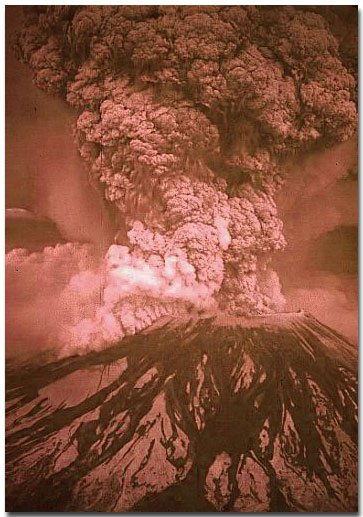
USGS photo of Mt. St. Helens by Austin Post May 18, 1980

Most volcanic activity (80%) is under water at the mid-ocean ridges. Here basaltic magma wells up from the mantle:
Click here to view a global relief map (notice the vast number of oceanic ridges).
Here new crust is made ... forming the longest chain of mountains on the earth. The reason this area is uplifted results from the fact that the crust is hot and expanded. As the seafloor spreads from this "hot zone", it cools ... contracts and settles.
The basaltic lava that flows out of the mid ocean ridges cools quickly and forms "pillow lava". Here are some links to video footage from the movie "Pele Meets the Sea" courtesy of Richard Pyle at Lava Video Productions.:
Small/Quicktime-1.7Mb
Large/Quicktime-8.0Mb
Small/AVI - 5.6Mb
Large/AVI - 18Mb
Volcanoes occur on land too. There are three basic types of land
volcanoes.
There are several famous stratovolcano eruptions - Toba
eruption in Sumatra, Indonesia -probably the biggest in the last 2 million
years (it erupted 75,000 years ago), Yellowstone
about 2.2 million years ago, Vesuvius,
Italy (79 AD) - Pompeii , Tambora,
Indonesia (1815) - The year without a summer, Mount
St. Helens Washington, USA (1980)... more here.

From the USGS |
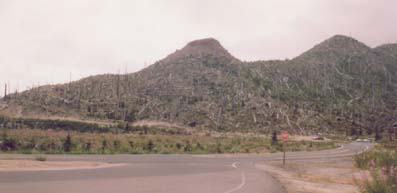
Mount St. Helens area 14 years after eruption. Trees fallen everywhere for 20 miles. |
Mt. Rainier (Washington State) could "blow" anytime! It could produce the worse natural disaster in the United States killing over 100,000 people mostly by debris flow (lahars).
Super Volcanoes - If that is not enough to keep you up at night .... records show that every once in a while, a "mega-volcano" blasts so much debris into the atmosphere that the earth could plunge into a mini-ice age (due to a lack of sunlight). It happened last 75,000 years ago when Toba (in Indonesia) blew. Read more here. Geologists have identified at least 4 known super-volcano in the past ..and it will happen again. If something like this happened today, millions of people would perish as crops failed on a global scale. Have a nice day ☺!
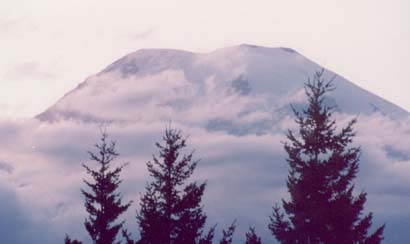
All these are produced by subducting oceanic crust, melting, and viscous lava trying to move to the surface.
 (animation)
(animation)
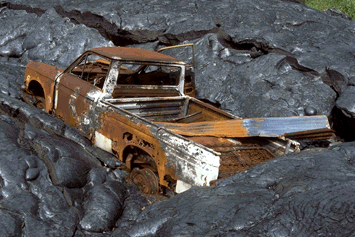
permission from Volcano
World http://volcano.und.nodak.edu/vwdocs/volc_tour/hawaii/kstemp.html
Pahoehoe flow (Hawaiians often lose their roads)
Some famous shield volcanoes are:
Kilauea (in Hawaii) is generally regarded as the world's most active volcano. It has been in a near-continuous eruption since 1983.
Mauna Loa (in Hawaii) is the largest volcano in the world. At a elevation of 13,681 feet, it has an estimated volume of 9,600 cubic miles.
Olympus Mons (a huge shield volcano on Mars) is the biggest known volcano in the solar system. It is about 17 miles tall (Mount Everest is about 6 miles tall).
 Olympus Mons (this
has base area the size of Wisconsin)
Olympus Mons (this
has base area the size of Wisconsin)
Credit NASA
In-class students will be watching a video on just this subject. The tape is Volcano's Deadly Warning by Nova. Click here for the study guide. The main point is that a volcanologist named Bernard Chouet has found a seismographic signal known as a type "B" wave which occurs just before a volcanic eruption. This relatively new discovery is a major breakthrough in the field of volcanology. It as already caught the attention of many volcanologists but needs further testing before it is foolproof.
Deaths by Volcano - click here.
Exposed volcanic neck - Devil's
Tower (Wyoming) All traces of the volcano has been eroded away
but the exposed volcanic pipe (neck) is still around ... making it a major
tourist attraction. This was featured in the movie -
Close Encounters
of the Third Kind. This is definitely worth the 30 miles you have to
detour off the main highway to visit.

Devil's Tower |
 |
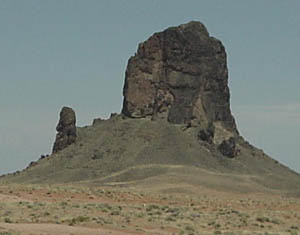 Heavily weathered
volcanic neck in Utah
Heavily weathered
volcanic neck in Utah
Caldera
- A caldera
is a large bowl-shaped crater that is formed by the collapse of a volcanic
cone after an eruption. Because large volumes of magma are removed from the interior of the
earth, the cone simply collapses. Sometimes leaving no trace of the
original cone itself as in the Yellowstone
caldera.
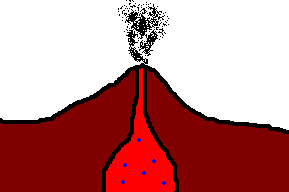 (animation)
(animation)

From the USGS photo by W.E. Scott
Crater Lake (and the cinder cone volcano, Wizard Island) in Oregon
In 2005 I spent a week at Crater Lake. It was, by far, the most beautiful area I've seen in the lower 50. If you go, make sure you take the boat trip and get off at Wizard Island. However, also make sure you take the very last boat (of the day) that drops you off at the island because you may be stranded there for an entire day (as I was) by taking the early morning boat.
IO (moon of
Jupiter) - When the Voyager probe flew by this moon, they were shocked
to find active volcanoes. This was most likely produced by tidal forces by
Jupiter and its neighboring moons ... generating heat in the interior of IO.
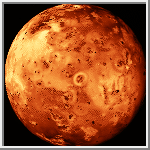 IO IO
Credit NASA |
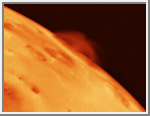
Volcano on IO Credit NASA |
Venus is known to have extensive volcanic features. 85% of its surface is volcanic! It was once thought that since Venus is just about the same size as earth and just slightly closer to the sun than the earth, it would show evidence of plate tectonics. It does NOT! Rather, it seems to release its heat through volcanic activity (which do not appear to be active today ... because there are too many meteor impact sites at the surface ... indicating an older surface). Perhaps the surface goes through periods of intense volcanism followed by long periods of non-activity???

Sif Mons
(on Venus)
Credit NASA
Links:
From the USGS on volcanoes
Lyrics to VOLCANO by Jimmy Buffett, Keith Sykes & Harry Dailey
Now, I don't know, I don't know where I'm a gonna go
when the volcano blow.
Let me say it now,
I don't know, I don't know where I'm a gonna go
when the volcano blow.
Ground, she movin' under me.
Tidal waves out on the sea.
Sulphur smoke up in the sky.
Pretty soon we learn to fly
Chorus
Let me hear you, now
I don't know, I don't know where I'm a gonna go
when the volcano blow.
Let me hear you now.
I don't know, I don't know where I'm a gonna go
when the volcano blow.
My girl quickly say to me,
"Mon you better watch your feet."
Lava come down soft and hot.
"You better lava me now or lava me not.
Chorus
No time to count what I'm worth,
cause I just left the planet Earth.
Where I go I hope there's rhum.
Not to worry mon soon come.
Chorus
But I don't want to land in New York City,
I don't want to land in Mexico.
I don't want to land on no Three Mile Island;
I don't want to see my skin a-glow.
Don't want to land in Comanche Sky Park,
or in Nashville, Tennessee.
I don't want to land in no San Juan airport or
the Yukon Territory.
Don't want to land no San Diego.
Don't want to land in no Buzzards Bay.
I don't want to land on no Ayatolla.
I got nothin' more to say.
Chorus
ŠJim Mihal 2004, 2006 - all rights reserved